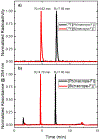Fluorine-18 incorporation and radiometal coordination in macropa ligands for PET imaging and targeted alpha therapy
- PMID: 39352495
- PMCID: PMC11649299
- DOI: 10.1039/d4cc04165h
Fluorine-18 incorporation and radiometal coordination in macropa ligands for PET imaging and targeted alpha therapy
Abstract
The development of theranostic agents for radiopharmaceuticals based on therapeutic alpha emitters marks an important clinical need. We describe a strategy for the development of theranostic agents of this type via the functionalization of the ligand with the diagnostic radionuclide fluorine-18. An analogue of macropa, an 18-membered macrocyclic chelator with high affinity for alpha therapeutic radiometals, was synthesized and its complexation properties with metal ions were determined. The new macropa-F ligand was used for quantitative radiometal complexation with lead-203 and bismuth-207, as surrogates for their alpha-emitting radioisotopes. As a diagnostic partner, a radiofluorinated macropa ligand was used for quantitative bismuth(III) and lead(II) complexation. All fluorine-18 and radiometal complexes are highly stable in human serum over several days. This study presents a new proof-of-principle approach for developing theranostic agents based on alpha-emitting radionuclides and fluorine-18.
Conflict of interest statement
Conflict of Interest
The authors T.K., Y. S. P. B, and J.J.W. are listed as inventors on a patent application related to this work.
Figures





References
-
- Lewis JS, Windhorst AD and Zeglis BM, Radiopharmaceutical Chemistry, Springer, Cham, Switzerland, 2019.
-
- Benešová M, Schäfer M, Bauder-Wüst U, Afshar-Oromieh A, Kratochwil C, Mier W, Haberkorn U, Kopka K and Eder M, J. Nucl. Med, 2015, 56, 914–920. - PubMed
-
- Kostelnik TI and Orvig C, Chem. Rev, 2018, 119, 902–956. - PubMed
MeSH terms
Substances
Grants and funding
LinkOut - more resources
Full Text Sources
Research Materials

